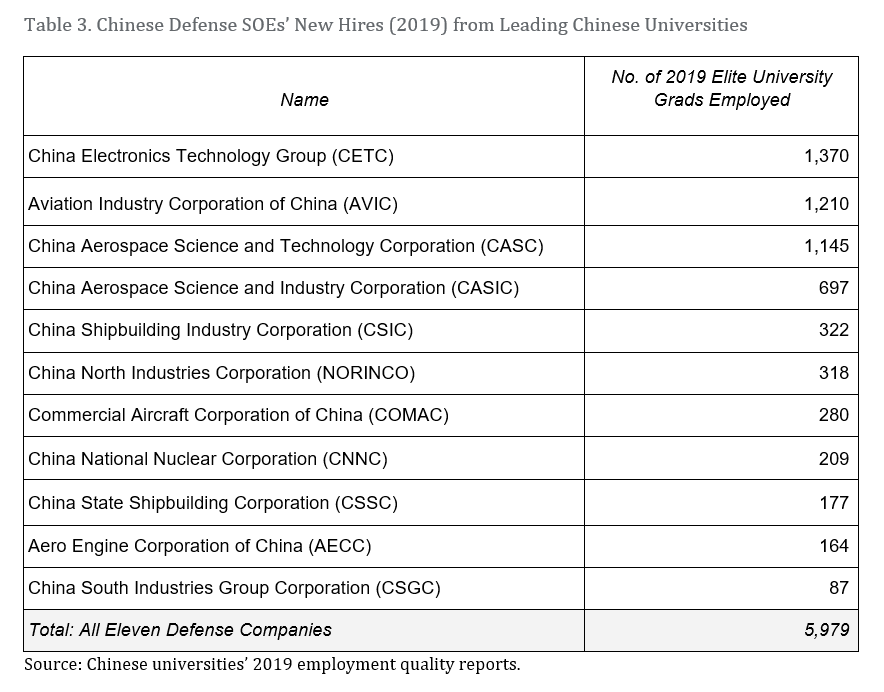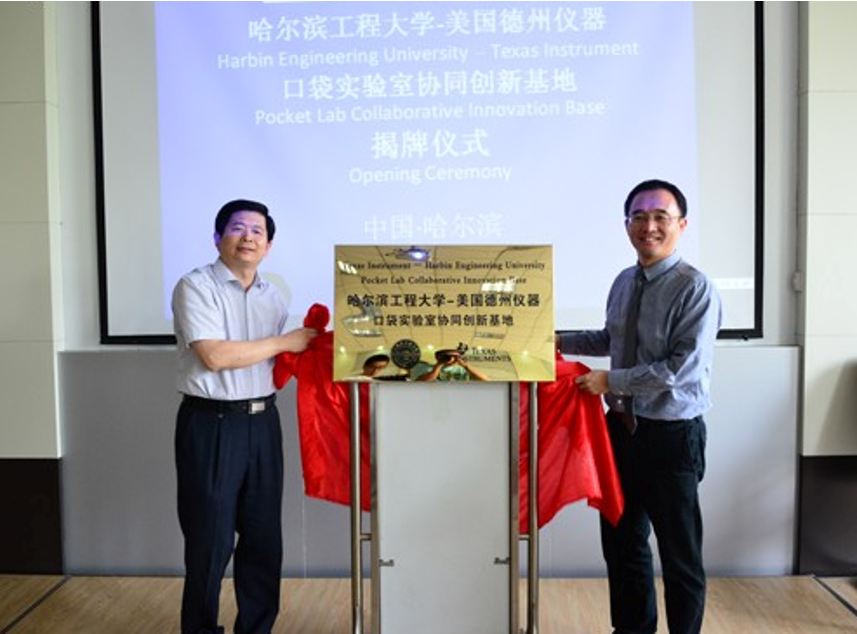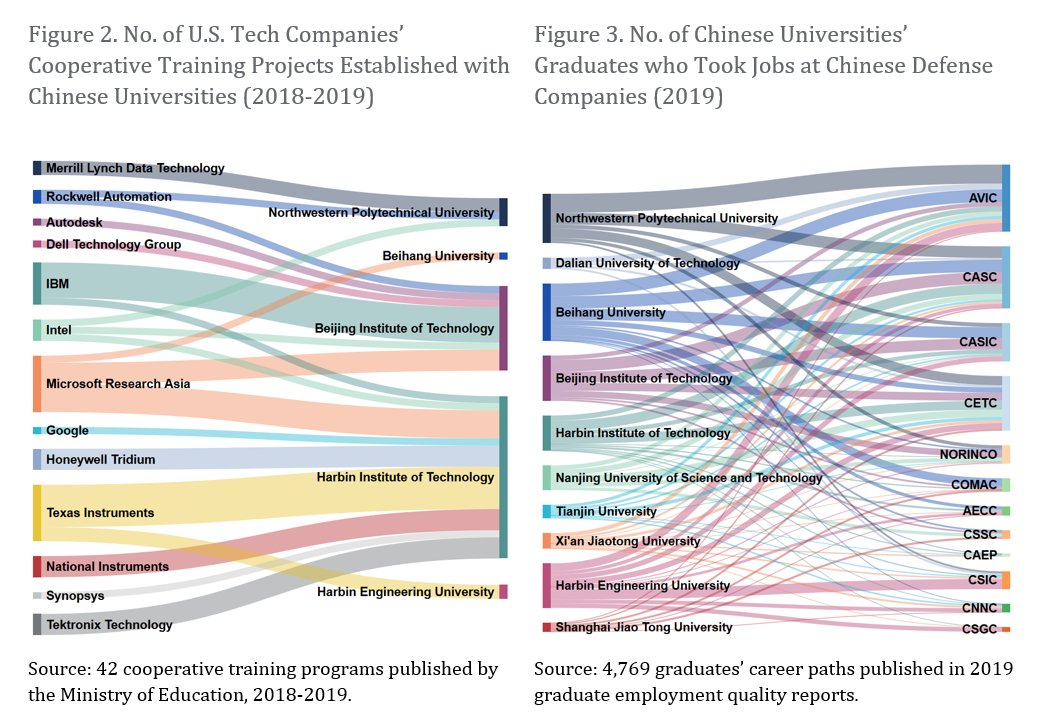
Who goes to work for China’s defense industry? In our latest, @emily_sw1 and I mapped talent flows between 🇨🇳 universities and defense SOEs.
🚨 We found that U.S. tech companies are indirectly aiding China's military.
Thread: (1/10) cset.georgetown.edu/research/unive…
🚨 We found that U.S. tech companies are indirectly aiding China's military.
Thread: (1/10) cset.georgetown.edu/research/unive…
2/10 In our report for @CSETGeorgetown, we measured the relationships between elite 🇨🇳 universities and China's defense industry by looking at their Graduate Employment Quality Reports.
Kudos to @alexjoske @ASPI_org for highlighting these sources: aspi.org.au/report/china-d…
Kudos to @alexjoske @ASPI_org for highlighting these sources: aspi.org.au/report/china-d…
3/10 We looked at disaggregated employment data for 29 of 45 leading universities—China’s Double First Class universities + those administered by MIIT.
Our dataset reflects the career moves of 140,000 Chinese university graduates in 2019.
6,000 took jobs at defense SOEs.
Our dataset reflects the career moves of 140,000 Chinese university graduates in 2019.
6,000 took jobs at defense SOEs.

4/10 We confirmed that 🇨🇳 defense giants like CASC, CETC, and CSIC disproportionately recruit from seven universities: the Seven Sons of National Defense (国防七子).
The Seven Sons produced just 16% of graduates in our dataset, but 72% of those who took jobs at defense SOEs.
The Seven Sons produced just 16% of graduates in our dataset, but 72% of those who took jobs at defense SOEs.

5/10 Then we started looking into the resources available to Chinese universities, investigating documents from the Ministry of Education.
MOE frequently "asks" foreign companies to help Chinese universities in research & curriculum development—the price of doing business in 🇨🇳.
MOE frequently "asks" foreign companies to help Chinese universities in research & curriculum development—the price of doing business in 🇨🇳.
6/10 The Seven Sons benefit from such collaborations, and so does China’s defense industry.
At MOE’s behest, 🇺🇸 tech companies have built the Seven Sons new lab facilities, trained faculty members, and developed course curricula on quantum computing, AI, and chip design.
At MOE’s behest, 🇺🇸 tech companies have built the Seven Sons new lab facilities, trained faculty members, and developed course curricula on quantum computing, AI, and chip design.

7/10 MOE documents specify that the 🇨🇳-based subsidiaries and joint ventures of
Autodesk, Dell, Google, Honeywell, IBM, Intel, Merrill Lynch, Microsoft, National Instruments, Rockwell Automation, Synopsys, Tektronix, and Texas Instruments
have partnered with the Seven Sons.
Autodesk, Dell, Google, Honeywell, IBM, Intel, Merrill Lynch, Microsoft, National Instruments, Rockwell Automation, Synopsys, Tektronix, and Texas Instruments
have partnered with the Seven Sons.
8/10 This has serious U.S. national security implications. MOE documents indicate @synopsys partnered with the PLA National University of Defense Technology on integrated circuit design.
Beijing has tried for decades to source the equipment and knowledge to build advanced ICs.
Beijing has tried for decades to source the equipment and knowledge to build advanced ICs.

9/10 Our report indicates the Seven Sons are responsible for training the next generation of China’s defense industry engineers.
More broadly, U.S. tech companies and universities should step up due diligence when engaging with Chinese research institutions.
More broadly, U.S. tech companies and universities should step up due diligence when engaging with Chinese research institutions.

10/10 Special thanks to Tai Ming Cheung, @ScottWHarold, and @tiffert for their reviews. Grateful to many folks at @CSETGeorgetown, especially the External Affairs team, who made this report possible.
As always, my DMs are open for any questions: cset.georgetown.edu/research/unive…
As always, my DMs are open for any questions: cset.georgetown.edu/research/unive…
Of interest to @niubi,@BethanyAllenEbr, @dwertime, @paulmozur, @Kate_OKeeffe,@jmulveno, @ElsaKania,@mattsheehan88, @JKynge
• • •
Missing some Tweet in this thread? You can try to
force a refresh




